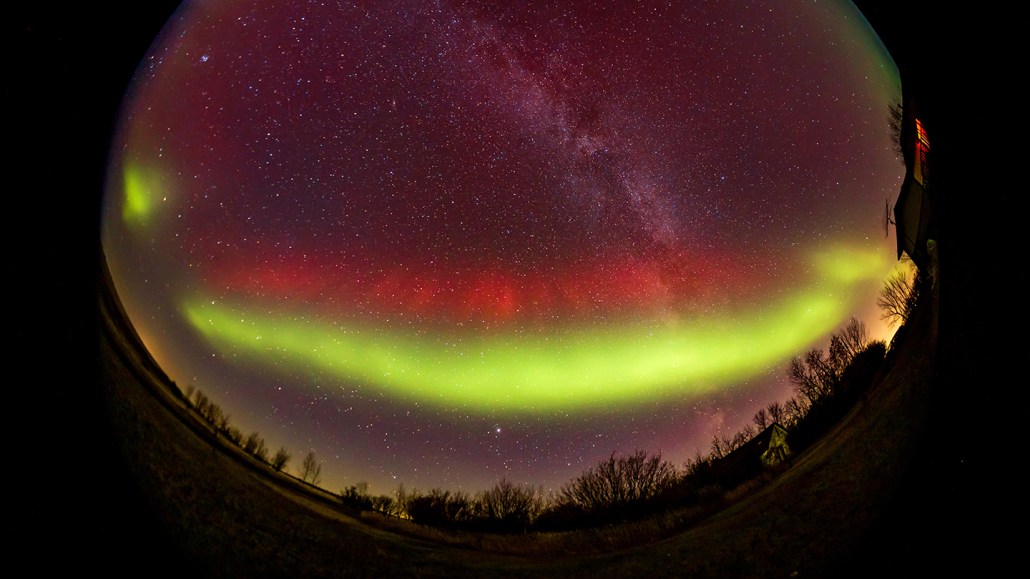Amateur astronomers reveal clues to a mysterious double aurora
These images of ‘Northern Lights’ may help explain a rare type of sky glow

Two different types of auroras (shown here as red and green) occurred at the same time in this image captured in Canada. This and similar images have revealed that the red glow might be caused by electrons raining down through Earth’s atmosphere.
© 2021 Alan Dyer/AmazingSky.com
Share this:
- Share via email (Opens in new window) Email
- Click to share on Facebook (Opens in new window) Facebook
- Click to share on X (Opens in new window) X
- Click to share on Pinterest (Opens in new window) Pinterest
- Click to share on Reddit (Opens in new window) Reddit
- Share to Google Classroom (Opens in new window) Google Classroom
- Click to print (Opens in new window) Print
By Asa Stahl
Double rainbows are one thing, but a double aurora? They can happen, though some kinds are rare. One particular red-and-green combo is especially puzzling. Now, images captured by amateur astronomers may help reveal its secrets.
Citizen scientists living in Canada and Finland used cameras to document an unusual combination of auroras in the night sky. Physicists have studied those images to learn what may have triggered the peculiar light show.
Alan Dyer was outside his home in Strathmore, Canada, when the dancing Northern Lights caught his attention. He grabbed his camera and started filming. “I knew I had something interesting,” says Dyer, a photographer who also writes about astronomy. His footage turned out to be the most complete record of this rarely seen phenomenon ever captured.
At first glance, the double aurora looks like a floating slice of watermelon. The rind — a shimmery green aurora — is well-understood. Scientists know that it’s caused when the solar wind energizes protons trapped within Earth’s magnetic field. Those protons rain down, bumping into electrons and atoms in their path. That’s what gives the green glow — called a proton aurora — its name.
The fruity looking red strip is more mystifying. Scientists have known about these “stable auroral red arcs” for decades. But there’s no agreement on how they form. One idea is that Earth’s magnetic field can heat up certain areas of the atmosphere. That heat could knock particles around, like in proton rain.
Researchers had seen these two types of auroras occur together before. But it was always mysterious, says Toshi Nishimura. He’s a space physicist at Boston University. “Scientists didn’t have a good idea of why they could be together.”
After looking at satellite observations along with the images captured by Dyer and others, Nishimura and his team concluded how the two phenomena might be related. The key is the thin rays in the red aurora. They mark the paths of electrons falling through the Earth’s magnetic field.
That means electron rain appears to trigger the red aurora, just as proton rain triggers the green one. Both get powered by the solar wind. But the electrons carry less energy than the protons, so they make for a more reddish color. The team reported its findings in JGR: Space Physics.
Electron rain might not be the only way to produce the stable red arcs, though, says Brian Harding. He’s a space physicist at the University of California, Berkeley. He says the results do show that what’s going on is more complicated than researchers had thought.
It’s important to understand those complications. The auroras Dyer saw could be danger zones for radio communication and GPS systems, says Nishimura. If you were driving under them, for instance, your GPS might tell you to veer off the road and into a field.
Scientists need to understand these red glows or they won’t be able to forecast space weather like they do normal weather, Harding explains. “You want to make sure that you can predict stuff like this.”
The citizen scientists who took the photos were a critical part of the new findings, Nishimura says. “This is a new way of doing research…. When they take more and more cool images, they find more and more things that we don’t know about.”
The photos will keep coming, says Dyer. “We can make a unique contribution to science,” he says. After all, “you never know what’s going to appear.”







